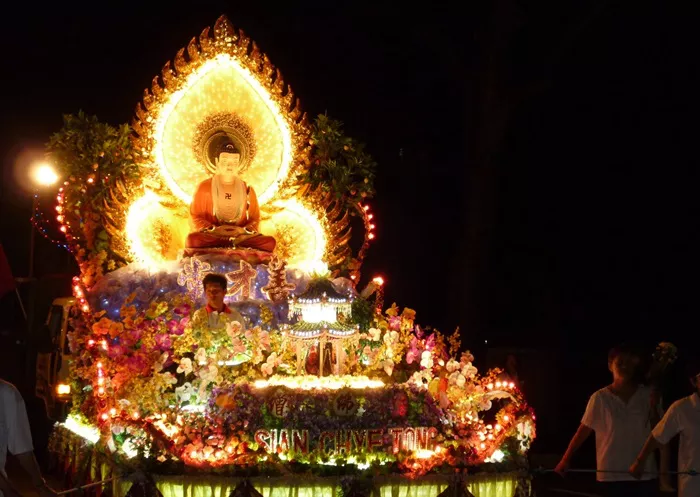Vesak, also known as Buddha Day, is the most significant festival in the Buddhist calendar. It commemorates the birth, enlightenment, and death (parinirvana) of Siddhartha Gautama, the Buddha. These three pivotal events are believed to have occurred on the same day, making Vesak a deeply meaningful occasion for Buddhists worldwide.
Historical Origins of Vesak
The term “Vesak” originates from the Sanskrit word “Vaisakha,” the name of the lunar month in which the full moon falls. This month corresponds to April or May in the Gregorian calendar. The celebration’s roots trace back to ancient India, where early Buddhists began observing the Buddha’s life events. Over time, the observance spread across Asia, adapting to local cultures and traditions.
Spread of Vesak Across Asia
As Buddhism spread from India to other parts of Asia, Vesak was embraced and modified to fit regional customs. In Southeast Asia, it became a public holiday, while in East Asia, it was integrated into existing Buddhist practices. Despite regional differences, the core themes of Vesak—honoring the Buddha’s life and teachings—remain consistent.
Significance of Vesak
Vesak holds profound spiritual significance for Buddhists. It serves as a reminder of the Buddha’s teachings on compassion, impermanence, and the path to enlightenment. Observing Vesak encourages practitioners to reflect on their own spiritual journey and to renew their commitment to the Buddhist path.
Commemoration of the Buddha’s Life Events
- Birth: Siddhartha Gautama was born in Lumbini, Nepal, under the Shakya clan. His birth is celebrated as a symbol of new beginnings and the potential for enlightenment in all beings.
- Enlightenment: At the age of 35, Siddhartha attained enlightenment under the Bodhi tree in Bodh Gaya, India. This event marks the realization of the Four Noble Truths and the path to Nirvana.
- Death (Parinirvana): The Buddha’s passing at the age of 80 in Kushinagar signifies the impermanence of all things and the ultimate liberation from the cycle of birth and death.
Promotion of Buddhist Values
Vesak emphasizes key Buddhist values such as:
- Compassion: Acting with kindness towards all living beings.
- Mindfulness: Being aware of one’s thoughts, actions, and their impacts.
- Generosity: Giving without expecting anything in return.
- Impermanence: Understanding that all things are transient and subject to change.
Celebrations of Vesak Around the World
Vesak is celebrated in various ways across different countries, reflecting the diverse cultures within the Buddhist community.
Southeast Asia
In countries like Sri Lanka, Thailand, and Cambodia, Vesak is a public holiday marked by:
- Temple Visits: Buddhists gather in temples to engage in prayers, meditation, and listen to sermons.
- Offerings: Devotees present flowers, incense, and candles as symbols of impermanence.
- Acts of Compassion: Activities such as releasing captive animals and distributing food to the needy are common.
East Asia
In East Asian countries like Japan and Korea, Vesak is celebrated with unique traditions:
- Japan: Known as Hana Matsuri, or the “Flower Festival,” it involves pouring sweet tea over statues of the baby Buddha.
- Korea: Celebrated as Seokga Tansinil, it features the Yeondeunghoe lantern festival, where colorful lanterns are displayed to symbolize the Buddha’s light.
South Asia
In India and Nepal, Vesak is observed with:
- Processions: Devotees participate in processions carrying images of the Buddha.
- Community Feasts: Sharing meals and sweets to foster a sense of community.
- Religious Services: Special prayers and readings from Buddhist scriptures are held.
Modern Observances and Global Recognition
In recent years, Vesak has gained international recognition. In 1999, the United Nations General Assembly declared the full moon day of Vesak as the International Day of Vesak, acknowledging its significance in promoting peace and harmony worldwide. The observance at UNESCO headquarters in Paris features cultural performances, discussions, and exhibitions highlighting the Buddha’s teachings and their relevance today.
Role of Technology and Media
With the advent of technology, many Buddhist communities have embraced digital platforms to celebrate Vesak. Virtual ceremonies, online teachings, and digital offerings allow practitioners worldwide to participate in the festivities, especially during times when travel and gatherings are restricted.
Conclusion
Vesak is more than just a festival; it is a time for Buddhists to reflect on the Buddha’s life and teachings, renew their commitment to the path of enlightenment, and promote values of compassion, mindfulness, and generosity. Whether celebrated in temples, homes, or online, Vesak serves as a reminder of the timeless wisdom that continues to guide millions on their spiritual journey.

